Doña María Eugenia Ignacia Agustina de Palafox y Kirkpatrick, 16th Countess of Teba, 15th Marchioness of Ardales, known as Eugénie de Montijo, was the last empress of the French as the wife of Emperor Napoleon III.
-
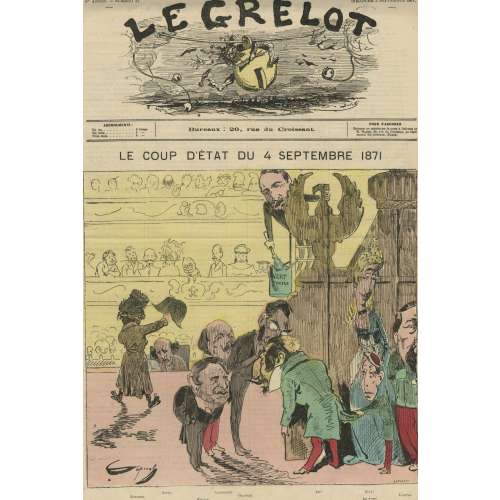 Le Grelot / journal illustré politique et satirique, №21, dimanche, 3 septembre 1871. Artist: Caporal (signed in the lower-left corner) Engraver/Printer: J. Lefman (signed LEFMAN SC in the lower-right corner) Title: LE COUP D'ÉTAT DU 4 SEPTEMBRE 1871. The Coup d'Etat of September 4th 1871. The artist equalled the 4th of September revolution when Napoleon III was ousted and the Second Empire collapsed, to a coup d'Etat. Although the number is marked September 3, it is dedicated to the events of September 4th. This was a usual French newspaper practice to postdate their issues. That's why they almost always operated with categories such as "today", "yesterday", and "tomorrow" instead of definitive calendar dates. "Le Grelot" means "The Sleigh Bell". Personages: Ratapoil – fictional personage invented by Honoré Daumier (French, 1808 – 1879), a Napoleon III caricaturized figure. Ratapoil is addressing the audience holding up Napoléon Bonaparte's tricorn cocked hat. Pietri – Joseph Marie Piétri [Joachim Piétri] (French, – is sitting in the first row, taking notes. Rouher – Eugène Rouher (French, 1814 – 1884), president of the Senat. Canrobert – François Marcellin Certain de Canrobert (French, 1809 – 1895), French Marshal, captured by the Prussian army in Metz with Marshal Bazaine during the surrender of Metz on October 28, 1870. Ollivier – Olivier Émile Ollivier (French, 1825 – 1913), head of the government. Hiding behind the theater decoration are: Napoleon III (Lui!), his wife Eugénie (Elle!), their son Prince Imperial (Le P'tit!), and Pierre Bonaparte (L'Autre). Sitting in the theatre box facing the scene: Adolphe Thiers (French, 1797 – 1877), Jules Favre (French, 1809 – 1880), Louis-Jules Trochu [Le General Trochu] (French, 1815 – 1896), and the other members of the "Government of National Defence". On the gallery: youngsters and two men in sans-culottes hats. An unidentified person on a ladder holding to an eagle figure is having a paintbrush and a bucket with 'tender green' paint. Ref: Musée Carnavalet
Le Grelot / journal illustré politique et satirique, №21, dimanche, 3 septembre 1871. Artist: Caporal (signed in the lower-left corner) Engraver/Printer: J. Lefman (signed LEFMAN SC in the lower-right corner) Title: LE COUP D'ÉTAT DU 4 SEPTEMBRE 1871. The Coup d'Etat of September 4th 1871. The artist equalled the 4th of September revolution when Napoleon III was ousted and the Second Empire collapsed, to a coup d'Etat. Although the number is marked September 3, it is dedicated to the events of September 4th. This was a usual French newspaper practice to postdate their issues. That's why they almost always operated with categories such as "today", "yesterday", and "tomorrow" instead of definitive calendar dates. "Le Grelot" means "The Sleigh Bell". Personages: Ratapoil – fictional personage invented by Honoré Daumier (French, 1808 – 1879), a Napoleon III caricaturized figure. Ratapoil is addressing the audience holding up Napoléon Bonaparte's tricorn cocked hat. Pietri – Joseph Marie Piétri [Joachim Piétri] (French, – is sitting in the first row, taking notes. Rouher – Eugène Rouher (French, 1814 – 1884), president of the Senat. Canrobert – François Marcellin Certain de Canrobert (French, 1809 – 1895), French Marshal, captured by the Prussian army in Metz with Marshal Bazaine during the surrender of Metz on October 28, 1870. Ollivier – Olivier Émile Ollivier (French, 1825 – 1913), head of the government. Hiding behind the theater decoration are: Napoleon III (Lui!), his wife Eugénie (Elle!), their son Prince Imperial (Le P'tit!), and Pierre Bonaparte (L'Autre). Sitting in the theatre box facing the scene: Adolphe Thiers (French, 1797 – 1877), Jules Favre (French, 1809 – 1880), Louis-Jules Trochu [Le General Trochu] (French, 1815 – 1896), and the other members of the "Government of National Defence". On the gallery: youngsters and two men in sans-culottes hats. An unidentified person on a ladder holding to an eagle figure is having a paintbrush and a bucket with 'tender green' paint. Ref: Musée Carnavalet -
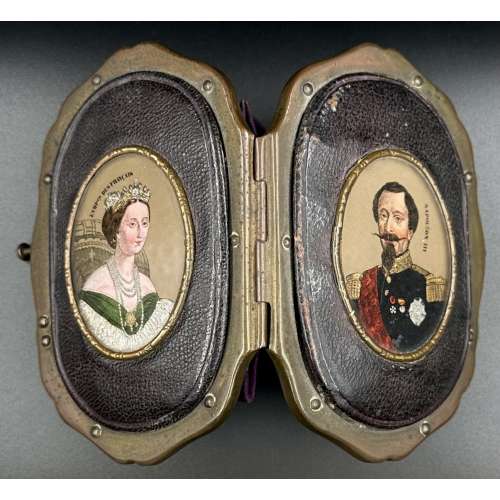 Coin purse, or porte-monnaie, made of patinated copper alloy, full-grain brown leather outside and purple inside, with a clutch and a hinge, and an oval miniature bust portrait on each side, painted in colour with gold and silver, by an anonymous artist after Franz Xaver Winterhalter, inscribed NAPOLÉON III and L'IMPCE DES FRANÇAIS, respectively, under glass. Dimensions: 97 x 67 x 18 mm. Contributors: Napoleon III [Charles Louis Napoléon Bonaparte] (French, 1808 – 1873) – character/sitter. Eugénie de Montijo [María Eugenia Ignacia Agustina de Palafox y Kirkpatrick] (Spanish-French, 1826 – 1920) – character/sitter. Franz Xaver Winterhalter (German, 1805 – 1873) – artist.
Coin purse, or porte-monnaie, made of patinated copper alloy, full-grain brown leather outside and purple inside, with a clutch and a hinge, and an oval miniature bust portrait on each side, painted in colour with gold and silver, by an anonymous artist after Franz Xaver Winterhalter, inscribed NAPOLÉON III and L'IMPCE DES FRANÇAIS, respectively, under glass. Dimensions: 97 x 67 x 18 mm. Contributors: Napoleon III [Charles Louis Napoléon Bonaparte] (French, 1808 – 1873) – character/sitter. Eugénie de Montijo [María Eugenia Ignacia Agustina de Palafox y Kirkpatrick] (Spanish-French, 1826 – 1920) – character/sitter. Franz Xaver Winterhalter (German, 1805 – 1873) – artist.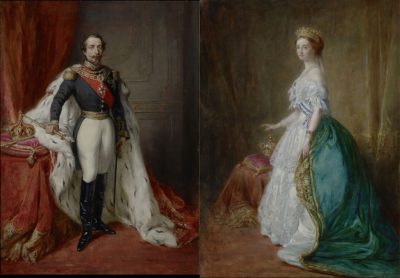
-
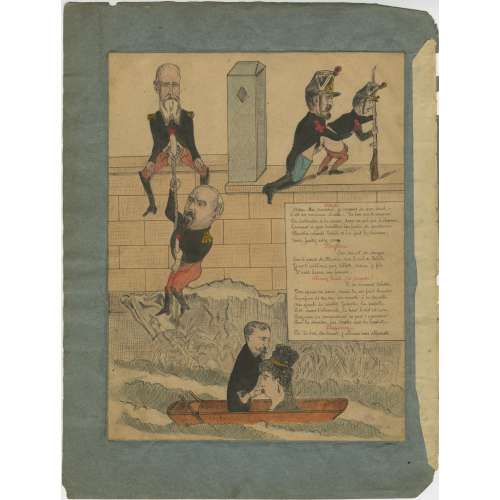 A series of seven political caricatures with indecent content, ink and pigment on paper, bound in a grey-blue folder. Each drawing is pasted to a grey-blue sheet of paper 32 x 24 cm. PLATES: 1) Villette; Bazaine; Alvarez Rull: 250 x 192 mm
A series of seven political caricatures with indecent content, ink and pigment on paper, bound in a grey-blue folder. Each drawing is pasted to a grey-blue sheet of paper 32 x 24 cm. PLATES: 1) Villette; Bazaine; Alvarez Rull: 250 x 192 mm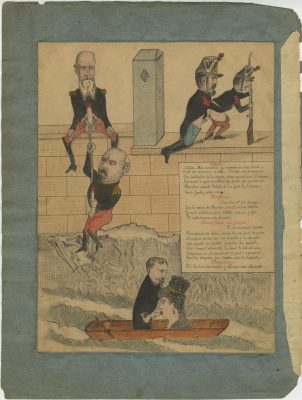
Villette Adieu, cher maréchal, je réponds de mon dard C’est un morceau d’acier… Là bas, sur le rempart, Sa cartouche à la main, dans un cul qui le charme, Lançant à gros bouillons son foutre de gendarme Plantin plante Delille et lui font le Caisson. Bazaine Sur ton vit de dragon Sur le nœud de Plantin, sur le cul de Delille, Je ne t’oublierai pas, Villette, adieu, je file Et je vais baiser ma femme. Alvarez Rull (à Josépha) Il ne saurait tarder, Ton epoux va venir, mais tu me fais bander, Le parfum de ton con me monte à la cervelle, Ma gaule se raidit . Josépha, la nacelle Est dans l’ obscurité, là haut, le ciel est noir, Bazaine en descendant ne peut t’ apercevoir … Pour la dernière fois, torche moi la houlette. Bazaine Eh ! là bas, du canot, j’allume une allumette!
Villette Farewell, dear Marshal, I vouch for my dick. It’s like a steel rod … Over there, on the ramparts, Plantin, his dick in hand, pounds Delisle’s beckoning ass And fills it with his bubbling gendarme’s cum. Bazaine For your dragoon’s dick, For Plantin's prick, for Delisle's ass, I won't forget you, Villette, goodbye, I'm leaving And I'm going to fuck my wife. Alvarez Rull (to Josépha) Hurry up, Your husband is coming, but I got a hard on you, The scent of your cunt penetrates my brain, My rod stiffened. Josépha, the gondola Is in the dark, the sky is black, Bazaine coming down and cannot see you... Give me one last blowjob.Bazaine Hey! Over there, from the canoe, I light a match!
French marshal Achille Bazaine capitulated to Bismarck during the Franco-Prussian war on 27 October 1870. In 1873, he was tried for treason and received a death sentence, later commuted to 20 years' imprisonment. Bazaine was incarcerated in the Fort Royal on Île Sainte-Marguerite, from which he escaped on August 9–10, 1874, with the help of Colonel Villette [Willette], his wife Josefa [Pepita Peña], and her nephew Alvarez Rull. They sailed to Genoa in Italy and from there to London. Plantin and Delisle were prison guards. The story was described in detail during the Trial of Col. Villette and his Accomplices in 1874 and published later in Robert Christophe. La Vie tragique du maréchal Bazaine. — Paris: Vautrain Jacques, 1947.
2) Impératrice Eugénie: 218 x 165 mm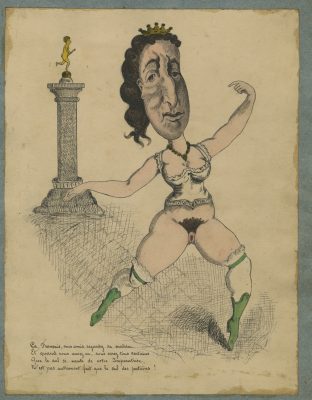
Ça, Français, mes amis, regardez sa matrice, Et quand vous aurez vu, vous serez tous certains Que le cul si vanté de votre Impératrice, N’est pas autrement fait que le cul des putains!
That, French, my friends, look at her cunt, And when you have seen, you will all be certain That the so acclaimed ass of your Empress, Is no different than the ass of whores! 3) Napoléon III: 215 x 168 mm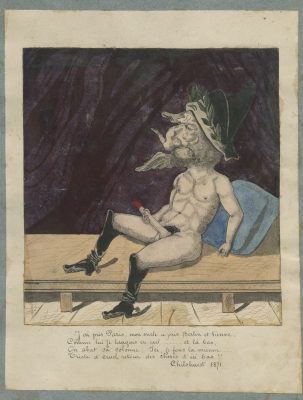
J’ai pris Paris, mon oncle a pris Berlin et Vienne. Comme lui je languis en exil …… et là bas, On abat sa colonne; Ici, je fous la mienne…. Triste et cruel retour des choses d’ici bas!! Chilshurst 1871. [i.e. Chislehurst]
I took Paris, my uncle took Berlin and Vienna. Like him, I, too, languish in exile. His column there was demolished; I’m jerking mine off here…. Cruel and sorrowful deeds!! 4) La confession: 216 x 168 mm (Georges Darboy?)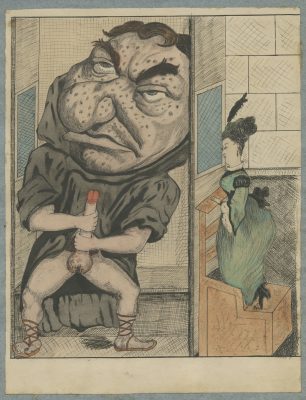 5) Napoléon III et Thérèsa (chanteuse Désirée Emma Valladon): 216 x 176 mm
5) Napoléon III et Thérèsa (chanteuse Désirée Emma Valladon): 216 x 176 mm
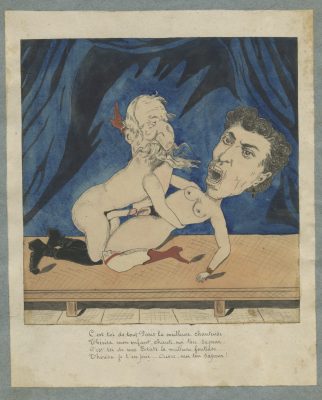
C’est toi de tout Paris la meilleure chanteuse, Thérèsa mon enfant, chante-moi ton sapeur. C’est toi de mes Etats la meilleure fonteuse.. Thérèsa je t’en prie … Ouvre-moi ton sapeur!
You, the best singer in all of Paris, Teresa, my child, sing for me where to insert. You are the best padding in my entire country… Teresa, please... Open your slit for me! 6) Thiers: 219 x 168 mm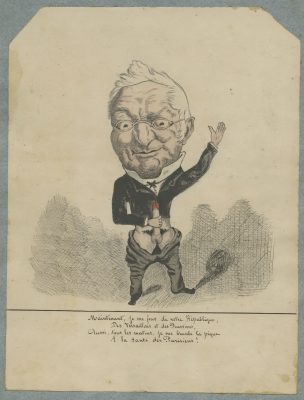
Maintenant, je me fous de votre République, Des Versaillais et des Prussiens, Aussi, tous les matins, je me branle la pique A la santé des Parisiens!
Yes, I don’t care about your Republic now, About Versailles and the Prussians, And every morning I jerk off For the health of Parisians! 7) Émile Ollivier/Rochefort/Jules Favre/Gambetta : 212 x 168 mm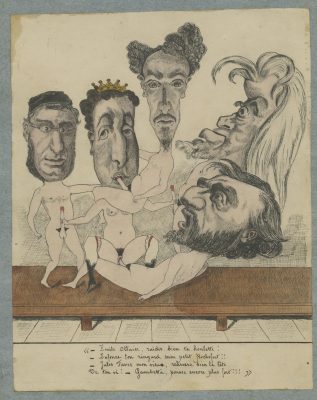
« — Emile Ollivier, raidis bien la houlette! — Enfonce ton ringard mon petit Rochefort!! — Jules Favre mon vieux, redresse bien la tête De ton vi! — Gambetta, pousse encore plus fort!!! »
Emile Ollivier, tighten your dick! - Stick in your poker, my little Rochefort!! - Jules Favre, old man, straighten your dickhead Damn it! – Gambetta, push even harder!!!Characters: Bazaine, François Achille (French, 1811 – 1888) Darboy, Georges (French, 1813 – 1871) Favre, Jules (French, 1809 – 1880) Gambetta, Léon (French, 1838 – 1882) Montijo, Eugénie de (Spanish-French, 1826 – 1920) Napoleon III [Bonaparte, Charles-Louis Napoléon] (French, 1808 – 1873) Ollivier, Émile (French, 1825 – 1913) Peña Azcárate, Josefa [Peña, Pepita] (Mexican-French, 1847 – 1900); Alvarez Rull – nephew of Josefa Peña Azcárate. Rochefort, Henri (French, 1831 – 1913) Thérésa [Valladon, Désirée Emma] (French, 1836 – 1913) Thiers, Adolphe (French, 1797 – 1877)
-
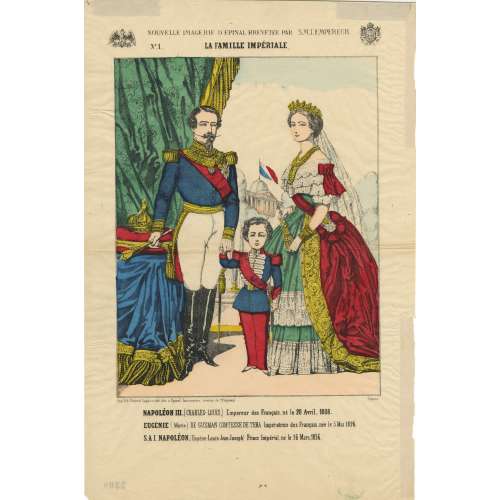 Hand-coloured woodcut on wove paper, 390 x 260 mm; black ink stamp “5308” to reverse; horizontal centerfold. Centre top: "NOUVELLE IMAGERIE D'ÉPINAL BREVETÉE PAR S.M.L’EMPEREUR" with imperial eagle and coat of arms at right and left. Below: "№ 1." — "LA FAMILLE IMPÉRIALE"; image in frame; under the image, left: "Imp lith. Pinot & Sagaire, édit. libr. à Épinal, fournisseurs brevetés de l’Empereur"; right: "Déposé". Bottom: "NAPOLÉON I. (CHARLES-LOUIS,) Empereur des Français, né le 20 Avril, 1808. | EUGÉNIE ( Marie) DE GUSMAN COMTESSE DE TEBA Impératrice des Français, née le 5 Mai 1826. | S.A I. NAPOLÉON. (Eugène-Louis-Jean-Joseph) Prince Impérial, ne le 16 Mars. 1856." Napoleon III [Charles-Louis Napoléon Bonaparte] (French, 1808 – 1873) Eugénie de Montijo [L'impératrice Eugénie] (Spanish-French, 1826 – 1920) Napoléon, Prince Imperial (Napoléon Eugène Louis Jean Joseph Bonaparte] (French, 1856 – 1879) Pinot & Sagaire (Épinal, 1861 – 1888) – enterprise, publisher/printer. Charles-François Pinot (French, 1817 – 1879) – publisher/printer.
Hand-coloured woodcut on wove paper, 390 x 260 mm; black ink stamp “5308” to reverse; horizontal centerfold. Centre top: "NOUVELLE IMAGERIE D'ÉPINAL BREVETÉE PAR S.M.L’EMPEREUR" with imperial eagle and coat of arms at right and left. Below: "№ 1." — "LA FAMILLE IMPÉRIALE"; image in frame; under the image, left: "Imp lith. Pinot & Sagaire, édit. libr. à Épinal, fournisseurs brevetés de l’Empereur"; right: "Déposé". Bottom: "NAPOLÉON I. (CHARLES-LOUIS,) Empereur des Français, né le 20 Avril, 1808. | EUGÉNIE ( Marie) DE GUSMAN COMTESSE DE TEBA Impératrice des Français, née le 5 Mai 1826. | S.A I. NAPOLÉON. (Eugène-Louis-Jean-Joseph) Prince Impérial, ne le 16 Mars. 1856." Napoleon III [Charles-Louis Napoléon Bonaparte] (French, 1808 – 1873) Eugénie de Montijo [L'impératrice Eugénie] (Spanish-French, 1826 – 1920) Napoléon, Prince Imperial (Napoléon Eugène Louis Jean Joseph Bonaparte] (French, 1856 – 1879) Pinot & Sagaire (Épinal, 1861 – 1888) – enterprise, publisher/printer. Charles-François Pinot (French, 1817 – 1879) – publisher/printer. -
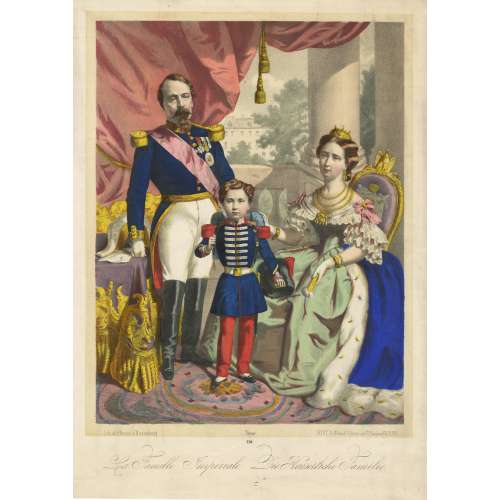 Hand-coloured lithography on wove paper, 395 x 280 mm; black ink stamp “5309” to reverse. On image: artist's initials "L. H."; on stone: "Lith. de Fr. Wentzel a Wissembourg. — Déposé — DÉPÔT, Fr. Wentzel Editeur rue St. Jacques 65, PARIS"; below centre: "239"; bottom : La famille Impériale. Die Kaizerliche Familie. Napoleon III [Charles-Louis Napoléon Bonaparte] (French, 1808 – 1873) Eugénie de Montijo [L'impératrice Eugénie] (Spanish-French, 1826 – 1920) Napoléon, Prince Imperial (Napoléon Eugène Louis Jean Joseph Bonaparte] (French, 1856 – 1879) Jean Frédéric Wentzel (French, 1807 – 1869) – publisher/printer.
Hand-coloured lithography on wove paper, 395 x 280 mm; black ink stamp “5309” to reverse. On image: artist's initials "L. H."; on stone: "Lith. de Fr. Wentzel a Wissembourg. — Déposé — DÉPÔT, Fr. Wentzel Editeur rue St. Jacques 65, PARIS"; below centre: "239"; bottom : La famille Impériale. Die Kaizerliche Familie. Napoleon III [Charles-Louis Napoléon Bonaparte] (French, 1808 – 1873) Eugénie de Montijo [L'impératrice Eugénie] (Spanish-French, 1826 – 1920) Napoléon, Prince Imperial (Napoléon Eugène Louis Jean Joseph Bonaparte] (French, 1856 – 1879) Jean Frédéric Wentzel (French, 1807 – 1869) – publisher/printer. -
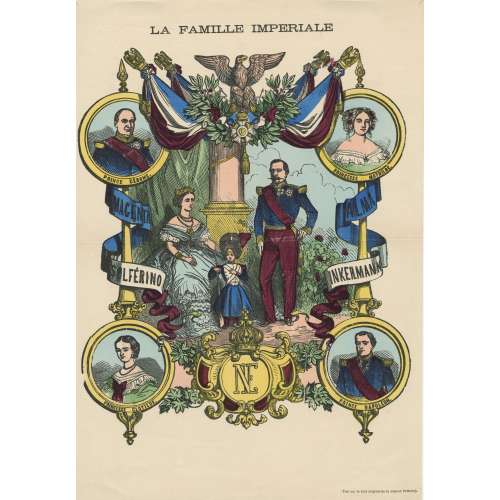 Hand-coloured woodcut on laid paper, 422 x 294 mm; black ink stamp “5307” to reverse, centrefold. Top center: "LA FAMILLE IMPERIALE"; Bottom right: "(Tire sur le bois original de maison Pellerin)". Image: Napoléon III, Empress Eugenie, and Prince Imperial Louis-Napoléon as a child surrounded with four lettered medallions: “PRINCE GÉROME”, “PRINCESSE MATHILDE”, “PRINCESSE CLOTILDE”, and “PRINCE NAPOLÉON”; ribbons lettered: “MAGENTA”, SOLFERINO”, “ALMA”, and “INKERMANN” around heraldic spears; coat of arms with imperial monogram between Princesse Clotilde and Prince Napoléon. Publisher/printer: Jean Charles Pellerin (French, 1756 – 1836). Battle of Magenta : 4 June 1859, against the Austrians. Battle of Solferino : 24 June 1859, against the Austrians. Battle of the Alma : 20 September 1854 (Crimean War) Battle of Inkerman : 5 November 1854 (Crimean War) Characters: Napoleon III [Charles-Louis Napoléon Bonaparte] (French, 1808 – 1873) Eugénie de Montijo [L'impératrice Eugénie] (Spanish-French, 1826 – 1920) Napoléon, Prince Imperial (Napoléon Eugène Louis Jean Joseph Bonaparte] (French, 1856 – 1879) Napoléon-Jérôme Bonaparte [Prince Jérôme] (French, 1822 – 1891) Mathilde Bonaparte [Princess Mathilde] (French, 1820 – 1904) Marie-Clotilde de Savoie [Princesse Clotilde] (French, 1843 – 1911)
Hand-coloured woodcut on laid paper, 422 x 294 mm; black ink stamp “5307” to reverse, centrefold. Top center: "LA FAMILLE IMPERIALE"; Bottom right: "(Tire sur le bois original de maison Pellerin)". Image: Napoléon III, Empress Eugenie, and Prince Imperial Louis-Napoléon as a child surrounded with four lettered medallions: “PRINCE GÉROME”, “PRINCESSE MATHILDE”, “PRINCESSE CLOTILDE”, and “PRINCE NAPOLÉON”; ribbons lettered: “MAGENTA”, SOLFERINO”, “ALMA”, and “INKERMANN” around heraldic spears; coat of arms with imperial monogram between Princesse Clotilde and Prince Napoléon. Publisher/printer: Jean Charles Pellerin (French, 1756 – 1836). Battle of Magenta : 4 June 1859, against the Austrians. Battle of Solferino : 24 June 1859, against the Austrians. Battle of the Alma : 20 September 1854 (Crimean War) Battle of Inkerman : 5 November 1854 (Crimean War) Characters: Napoleon III [Charles-Louis Napoléon Bonaparte] (French, 1808 – 1873) Eugénie de Montijo [L'impératrice Eugénie] (Spanish-French, 1826 – 1920) Napoléon, Prince Imperial (Napoléon Eugène Louis Jean Joseph Bonaparte] (French, 1856 – 1879) Napoléon-Jérôme Bonaparte [Prince Jérôme] (French, 1822 – 1891) Mathilde Bonaparte [Princess Mathilde] (French, 1820 – 1904) Marie-Clotilde de Savoie [Princesse Clotilde] (French, 1843 – 1911) -
 Hand-coloured woodcut on wove paper, 400 x 270 mm; black ink stamp “5306” to reverse. Top centre: "FAMILLE IMPÉRIALE", right: "62."; below centre: "Fabrique d'Images de GANGEL et P. DIDION, à Metz."; right: "Déposé." Publisher/printer: Gangel et P. Didion (Metz); Paulin Didion (French, 1831 – 1879). Characters: Napoleon III [Charles-Louis Napoléon Bonaparte] (French, 1808 – 1873) Eugénie de Montijo [L'impératrice Eugénie] (Spanish-French, 1826 – 1920) Napoléon, Prince Imperial (Napoléon Eugène Louis Jean Joseph Bonaparte] (French, 1856 – 1879) Napoléon II [Napoléon François Joseph Charles Bonaparte] (French, 1811 – 1832) Napoléon Ier [Napoléon Bonaparte] (French, 1769 – 1821)
Hand-coloured woodcut on wove paper, 400 x 270 mm; black ink stamp “5306” to reverse. Top centre: "FAMILLE IMPÉRIALE", right: "62."; below centre: "Fabrique d'Images de GANGEL et P. DIDION, à Metz."; right: "Déposé." Publisher/printer: Gangel et P. Didion (Metz); Paulin Didion (French, 1831 – 1879). Characters: Napoleon III [Charles-Louis Napoléon Bonaparte] (French, 1808 – 1873) Eugénie de Montijo [L'impératrice Eugénie] (Spanish-French, 1826 – 1920) Napoléon, Prince Imperial (Napoléon Eugène Louis Jean Joseph Bonaparte] (French, 1856 – 1879) Napoléon II [Napoléon François Joseph Charles Bonaparte] (French, 1811 – 1832) Napoléon Ier [Napoléon Bonaparte] (French, 1769 – 1821) -
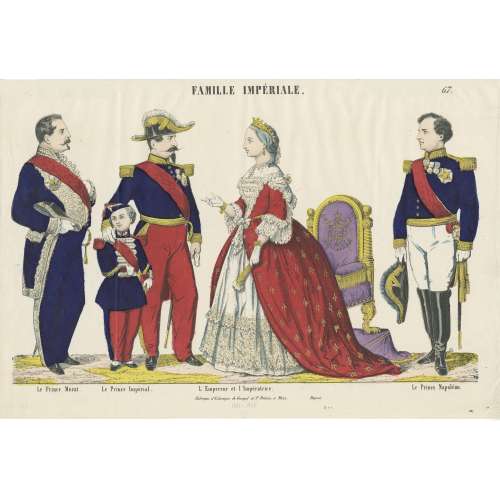 Hand-coloured woodcut on wove paper, 288 x 426 mm; black ink stamp “5305” to reverse. Top centre: "FAMILLE IMPÉRIALE", right: "67." Under the image: "Le Prince Murat." — "Le Prince Impérial." — "L' Empereur et l'Impératrice." — "Le Prince Napoléon." Bottom: "Fabrique d'Estampes de Gangel et P. Didion, à Metz." — "Déposé." Bottom: ms in pencil "1861 – 1868". Publisher/printer: Gangel et P. Didion (Metz); Paulin Didion (French, 1831 – 1879). Characters: Napoleon III [Charles-Louis Napoléon Bonaparte] (French, 1808 – 1873) Eugénie de Montijo [L'impératrice Eugénie] (Spanish-French, 1826 – 1920) Napoléon, Prince Imperial (Napoléon Eugène Louis Jean Joseph Bonaparte] (French, 1856 – 1879) Prince Murat [Lucien Charles Joseph Napoléon] (French, 1803 – 1878) Napoléon-Jérôme Bonaparte [Prince Napoléon] (French, 1822 – 1891)
Hand-coloured woodcut on wove paper, 288 x 426 mm; black ink stamp “5305” to reverse. Top centre: "FAMILLE IMPÉRIALE", right: "67." Under the image: "Le Prince Murat." — "Le Prince Impérial." — "L' Empereur et l'Impératrice." — "Le Prince Napoléon." Bottom: "Fabrique d'Estampes de Gangel et P. Didion, à Metz." — "Déposé." Bottom: ms in pencil "1861 – 1868". Publisher/printer: Gangel et P. Didion (Metz); Paulin Didion (French, 1831 – 1879). Characters: Napoleon III [Charles-Louis Napoléon Bonaparte] (French, 1808 – 1873) Eugénie de Montijo [L'impératrice Eugénie] (Spanish-French, 1826 – 1920) Napoléon, Prince Imperial (Napoléon Eugène Louis Jean Joseph Bonaparte] (French, 1856 – 1879) Prince Murat [Lucien Charles Joseph Napoléon] (French, 1803 – 1878) Napoléon-Jérôme Bonaparte [Prince Napoléon] (French, 1822 – 1891) -
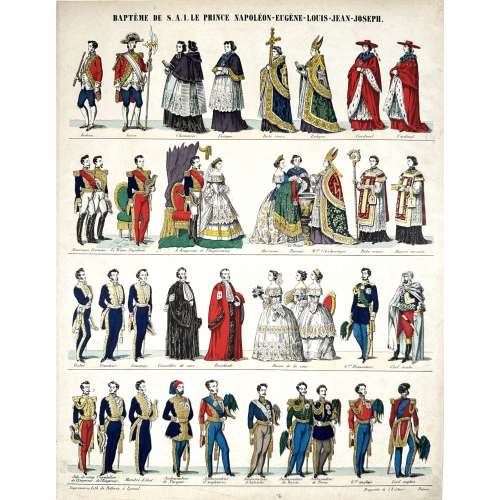 Hand-coloured woodcut on wove paper, 460 x 363 mm; black ink stamp “5054” to reverse. Four tiers with groups of people dressed in uniform, captioned: Bedeau — Suisse — Chanoines — Évêque — Porte croix — Évêque — Cardinal — Cardinal | Généraux français — Le prince Napoléon — L’Empereur et l’Impératrice — Marraine — Le Prince — Parrain | Meur l’Archevêque | Porte crosse Diacre servant | Préfet — Sénateur — Conseiller de cour — Président — Dames de la cour — Gral Piémontais — Chef arabe | Aide-de-camp de l’Empereur — Chambellan de l’Empereur — Ministre d’état — Ambassadeur de Turque | Ambassadeur d’Angleterre — Ambassadeur d’Autriche — Ambassadeur de Russie — Ambassadeur de Prusse — Gral anglaise — Lord anglais || Bottom left: Imprimerie Lith. de Pellerin, à Épinal; right: Propriété de l’Éditeur. — Déposé. Jean Charles Pellerin (French, 1756 – 1836) – printer/publisher.
Hand-coloured woodcut on wove paper, 460 x 363 mm; black ink stamp “5054” to reverse. Four tiers with groups of people dressed in uniform, captioned: Bedeau — Suisse — Chanoines — Évêque — Porte croix — Évêque — Cardinal — Cardinal | Généraux français — Le prince Napoléon — L’Empereur et l’Impératrice — Marraine — Le Prince — Parrain | Meur l’Archevêque | Porte crosse Diacre servant | Préfet — Sénateur — Conseiller de cour — Président — Dames de la cour — Gral Piémontais — Chef arabe | Aide-de-camp de l’Empereur — Chambellan de l’Empereur — Ministre d’état — Ambassadeur de Turque | Ambassadeur d’Angleterre — Ambassadeur d’Autriche — Ambassadeur de Russie — Ambassadeur de Prusse — Gral anglaise — Lord anglais || Bottom left: Imprimerie Lith. de Pellerin, à Épinal; right: Propriété de l’Éditeur. — Déposé. Jean Charles Pellerin (French, 1756 – 1836) – printer/publisher. -
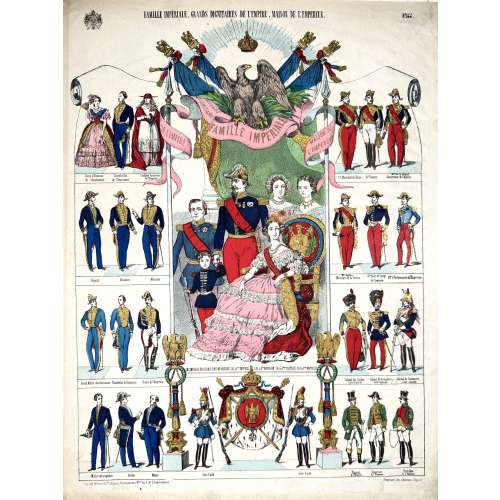 Hand-coloured woodcut on wove paper, 487 x 365 mm; black ink stamp “5056” to reverse. Top left: imperial coat of arms; centre: "FAMILLE IMPERIALE. GRANDS DIGNITAIRES DE L'EMPIRE, MAISON DE L'EMPEREUR."; right: "№144." Image of the imperial family under imperial eagle and standards; besides – four tiers of captioned cartoons. Bottom left: "Imprimerie Lith. de Pellerin, à Épinal"; right: "Propriété de l’Éditeur. — Déposé." Jean Charles Pellerin (French, 1756 – 1836) – printer/publisher.
Hand-coloured woodcut on wove paper, 487 x 365 mm; black ink stamp “5056” to reverse. Top left: imperial coat of arms; centre: "FAMILLE IMPERIALE. GRANDS DIGNITAIRES DE L'EMPIRE, MAISON DE L'EMPEREUR."; right: "№144." Image of the imperial family under imperial eagle and standards; besides – four tiers of captioned cartoons. Bottom left: "Imprimerie Lith. de Pellerin, à Épinal"; right: "Propriété de l’Éditeur. — Déposé." Jean Charles Pellerin (French, 1756 – 1836) – printer/publisher. -
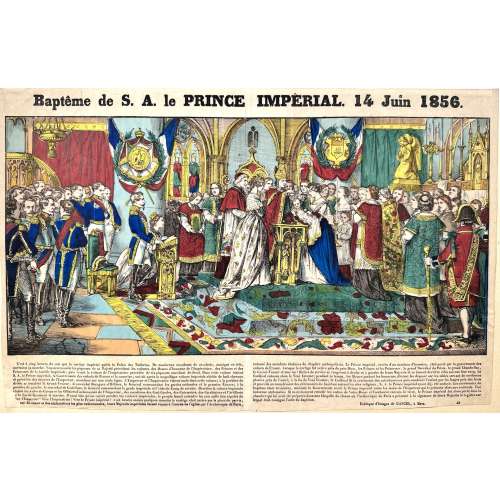 Hand-coloured woodcut on wove paper, 610 x 390 mm; black ink stamp “5207” to reverse, attached to a larger sheet of thick paper with a red ink stamp: “COLLECTION JEAN-CLAUD LACHNITT | REPRODUCTION INTERDIT”. Top: Baptême de S. A. le PRINCE IMPÉRIAL. 14 Juin 1856; image of baptism of Prince-Impérial; two-column text with a small loss in the lower left corner (C'est à cinq heures du soir que le cortège impérial quitta le Palais des Tuileries. De nombreux escadrons de cavalerie, musique en tête ouvraient la marche. ...); bottom under the text: "Fabrique d'Images de GANGEL, à Metz." — "49".
Hand-coloured woodcut on wove paper, 610 x 390 mm; black ink stamp “5207” to reverse, attached to a larger sheet of thick paper with a red ink stamp: “COLLECTION JEAN-CLAUD LACHNITT | REPRODUCTION INTERDIT”. Top: Baptême de S. A. le PRINCE IMPÉRIAL. 14 Juin 1856; image of baptism of Prince-Impérial; two-column text with a small loss in the lower left corner (C'est à cinq heures du soir que le cortège impérial quitta le Palais des Tuileries. De nombreux escadrons de cavalerie, musique en tête ouvraient la marche. ...); bottom under the text: "Fabrique d'Images de GANGEL, à Metz." — "49".


